Pitched Battles ’22-23 S1
This battlepack presents this season’s rules for playing Pitched Battles as part of a matched play event. Each season we will provide a new set of rules that includes an exclusive setting for your battles to take place in, new grand strategies, battle tactics, realm rules and battleplans. This season is set in Gallet, the Splintered Land.
Contents  6 Turf War 6 Turf War | ||
Books
| Book | Kind | Edition | Last update | |
 General’s Handbook ’2022: Pitched Battles 2022-23 Season 1 General’s Handbook ’2022: Pitched Battles 2022-23 Season 1 | ||||
 General’s Handbook ’2022: Pitched Battles 2022-23 Season 1 General’s Handbook ’2022: Pitched Battles 2022-23 Season 1 | Expansion | 3 | October 2022 | |
FAQ
| Q: | If I add units to a Pitched Battle army after a battle has started, can I do so in excess of any limits that apply? For example, could I summon extra Behemoths if my army already included the maximum number it can take? |
| A: | The limits on the number of Leaders, Artillery units and Behemoths only apply when you are picking your army, so you can ignore these limits when you add these kinds of units to your army. The limit on Unique units still applies, however (you can never have more than 1 of the same type of Unique unit in your army). |
| Q: | If a Pitched Battle Profile for a unit appears in the most recent General’s Handbook, can I use that unit in Pitched Battles even if that unit is not listed in the table of a specific faction? |
| A: | Yes. |
| Q: | If I have multiple abilities and other effects to be applied at the start of my hero phase, can I apply them before I pick my battle tactic? |
| A: | Yes. |
| Q: | Can I gain control of multiple objectives in ‘The Lurkers Below’ in the same turn? |
| A: | No. |
| Q: | Can I set up faction terrain features in the ‘Battlelines Drawn’ battleplan? |
| A: | Yes. The quarters of the battlefield in this battleplan are only treated as objectives and do not prevent you from setting up models or terrain features. |
| Q: | Can I set up gravesites using the Soulblight Gravelords battle trait ‘The Unquiet Dead’ in the ‘Battlelines Drawn’ battleplan? |
| A: | Yes, see above. |
| Q: | If an effect would increase the Wounds characteristic of a GALLETIAN VETERANS unit above the required threshold, does that unit lose the GALLETIAN VETERANS keyword? |
| A: | No. |
| Q: | If I add a unit to my army after the battle begins, and that unit meets the requirements to gain the GALLETIAN VETERANS keyword, does that unit gain the keyword? |
| A: | Yes. |
| Q: | If I add a unit to my army after the battle begins, and that unit has the Battleline battlefield role, does that unit count as a Battleline unit for the purposes of rules, battle tactics and grand strategies? |
| A: | Yes. |
| Q: | Is it possible to complete the grand strategy Show of Dominance by having one GALLETIAN VETERANS unit in the centre of the battlefield which has one or more models within each table quarter? |
| A: | Yes. |
| Q: | In the ‘Battlelines Drawn’ battleplan, can you remove a unit from the battlefield in order to enter a garrison (and set it up again when you leave a garrison)? |
| A: | Yes. |
| Q: | Do models in the Expert Conquerors battalion count as 3 models for the purposes of contesting a terrain feature (for example, for the ‘Desecrate their Lands’ battle tactic)? |
| A: | Yes. |
Getting Started
- First, you need to do is agree on the points limit for the battle.
- Next, pick 1 faction for your army and consult the Pitched Battles table to see the restrictions that apply when picking your units.
- Then, record the details of your army on your army roster. This includes the grand strategy you have selected, the units you have included and the enhancements you have picked for them.
- Finally, determine the battleplan you will play, making sure that you have read the realm rules before the battle begins. All that remains is to fight the battle itself!
Pitched Battles
Battles fought using this battlepack are Pitched Battles. The following rules apply to battles fought using this battlepack:1. Points Limit
You and your opponent will first need to agree on a points limit for the battle. The points limit for the battle can be either 1000 or 2000. After you have agreed on a points limit, look it up on the Pitched Battles table below. The table lists the restrictions on what the players can include in their armies.
| |||||||||||||||||||||||||||||||||
2. Pick Your Army
Next, you must pick your army following the restrictions below.| See Pitched Battle Publications 2022-23 - Season 2 for a list of publications whose rules you are allowed to use when picking your army. | ||
Faction
You must pick 1 faction for your army. All of the units in your army must be from a single faction.Battlefield Roles
The Pitched Battles table lists the minimum number of Leader and Battleline units you must include in your army and the maximum number of Leader, Behemoth and Artillery units you can include in your army.Your general must have the Leader battlefield role. A model that has both the Leader and Behemoth battlefield roles counts as 1 Leader and 1 Behemoth in your army. If a unit has both the Battleline and Behemoth battlefield roles, that unit does not count toward the maximum number of Behemoth units you can include in your army.
| Remember that allied units are ignored when determining if the units in the army are from a single faction (core rules, 27.1). | ||
Battalions
You can include core battalions in your army but you cannot include warscroll battalions.Understrength and Reinforced Units
The Pitched Battles table lists how many reinforced units you can include in your army. Only Battleline units can be reinforced twice. You cannot include understrength units in a Pitched Battle army.Allied Units
The maximum number of points that you can spend on allies from your points allowance is shown on the Pitched Battles table. Allied units do not count towards the number of Battleline units in your army. However, they do count towards the maximum number of Leader, Behemoth and Artillery units in your army.Coalition Units
Coalition units do not count towards the number of Battleline units in your army. However, they do count towards the maximum number of Leader, Behemoth and Artillery units in your army. In addition, Coalition units are ignored when determining if the units in your army are from a single faction.Endless Spells and Invocations
The Pitched Battles table lists the maximum number of endless spells and invocations you can include in your army. You cannot include the same endless spell or invocation more than once in your army.3. Fill Out Your Army Roster
Once you have picked your army, record the details on your army roster and show it to your opponent before setting up your army at the start of the battle. Your roster must include a list of the units, battalions, endless spells and invocations in your army; what size the units are; which units are in each battalion; the army’s faction; the grand strategy you have picked; which units are allies; and which model is the army’s general.Use the Notes column on the roster to record the command models you have chosen for each unit, the spells and prayers that are known by the WIZARDS and PRIESTS in your army, any artefacts of power you have given to HEROES in your army, and the command trait you have chosen for your general. If your army includes any units that are given keywords when they are set up, such as units with a Mark of Chaos, these keywords must be written down when the unit is added to the roster.
Grand Strategies
When you are filling out your army roster, you can pick 1 grand strategy. Your grand strategy represents what your army is trying to accomplish, and achieving it can make all the difference in a closely fought battle. The rules for how to use grand strategies can be found here.4. To War!
After you and your opponent have filled out your army rosters, it’s time to determine the battleplan that you will use. In this section you will find special rules that apply to battles fought using this battlepack.Pitched Battle Battleplans
The players roll off and the winner rolls a dice. On a 1-3, Battleplan Table 1 is used; on a 4-6, Battleplan Table 2 is used (see below). Then, their opponent rolls a dice to determine which battleplan is used for the game.Battle Tactics
Battle tactics are secondary objectives that the armies can attempt to achieve as the opportunity presents itself during the battle. Each battle tactic you pick will give you a new goal for your army to aim for in each of your turns. The rules for how to use battle tactics can be found here.Realm Rules
You must use the Gallet, the Splintered Land realm rules.Terrain Features
The Pitched Battles table lists the recommended minimum number of terrain features to be set up on the battlefield. Each terrain feature must be set up more than 3" from the battlefield edge, more than 6" from all other terrain features and more than 3" from all objectives. If it is impossible for a terrain feature to be set up, it is not used.| Some events will have battlefields with terrain features that have been set up before both players arrive at the table, or the position of terrain features may have been predetermined by a third party. If this is the case, the players roll off to determine who is the attacker and defender as normal, with the attacker picking the territory in which they wish to deploy and setting up the first unit. If a faction terrain feature must be set up before any other terrain features and the battlefield has already been set up by a third party, set up that faction terrain feature before territories are determined. | ||
Faction Terrain
Faction terrain features must be set up more than 3" from all other terrain features and more than 3" from all objectives. These restrictions are in addition to the set-up rules in the battletome in which they appear. If it is impossible for a faction terrain feature to be set up, it is not used.Mysterious Terrain
The defender must roll on the Mysterious Terrain table from the core rules (see 28.1.3) to determine additional scenery rules that apply to any terrain features that do not have a warscroll. Roll on the Mysterious Terrain table for each applicable terrain feature after it has been set up.Alternating Deployment
If a battleplan says that the players use alternating deployment, then the players alternate setting 1 unit at a time. The players continue to set up their units until both armies have been set up. If one player finishes setting up their army first, their opponent must set up the rest of the units in their army, one after another.Stealing the Initiative
Do not roll off to determine who has priority in the first battle round. Instead, the player who finished deploying their army first has priority in the first battle round.Realm Rules
Region of War: Gallet, The Splintered Land
The following rules reflect what it is like to do battle in the cracked and cyclone-scoured lands of Gallet in Ghur. Only the hardiest fighters survive for long amidst this continent’s unforgiving environments.
Special Rules
Masters of the Splintered Land: Whether through brute strength, great cunning or sheer skill at arms, there are certain warriors who seem to thrive amidst the harsh conditions of Gallet.Friendly Battleline units that have a Wounds characteristic of 4 or less and do not have mounts gain the GALLETIAN VETERANS keyword.
Proving Grounds: Gallet is scarred with caverns and craters that echo to the territorial clashes between its indigenous fauna. In times of war, these hollows swiftly become blood-soaked fighting pits amongst which the most fearsome warriors fight for dominance.
At the start of each battle round, after the players have determined who will take the first turn, the player who will take the second turn can pick 1 objective on the battlefield to be the proving ground until the end of that battle round. The same objective cannot be picked as the proving ground more than once per battle, and only 1 objective can be marked as the proving ground at any one time. Only models in units with the GALLETIAN VETERANS keyword can contest an objective marked as the proving ground.
The Bonds of Battle: Warriors accustomed to fighting in the cramped tunnels and caverns beneath the surface of Gallet have learned ways of bringing more of their number to bear in close confines. For those of a savage disposition, this may simply mean combining their brawn and mass with that of their fellows to bull over and crush the enemy, while more disciplined fighters may have trained to aim strikes over the heads of their comrades or through gaps in the front rank.
When a model in a GALLETIAN VETERANS unit makes an attack with a melee weapon, you can target an enemy unit within 1/2" of another model from that GALLETIAN VETERANS unit instead of using the weapon’s Range characteristic for that attack. If you do so, the attacking model must be within 1/2" of another model from its own unit that is within 1/2" of the target.
Realmsphere Magic
All WIZARDS know the following spell in addition to any others that they know:Gaze of Ghur: Harnessing every ounce of their power, the wizard channels the predatory hunger of the Amber Realm, itself invoking in the foe a primal fear that drives them to focus all their efforts upon self-preservation rather than the objectives they have been assigned.
Gaze of Ghur is a spell that has a casting value of 7 and a range of 12". If successfully cast, pick 1 enemy unit within range and visible to the caster. Until your next hero phase, when determining the number of models in that enemy unit that are contesting an objective, your opponent must halve that number, rounding down.
Designer’s Note: Effects that modify the number of models a model counts as when contesting an objective are applied after effects that fix the number of models a model counts as when contesting an objective at a set value. For example, if a MEGA-GARGANT counts as 20 models because of the ‘Mightier Makes Rightier’ battle trait, ‘Gaze of Ghur’ would make that unit count as 10 models instead.
Realm Command
Each player can use the following command ability in addition to any other that they can use:Overwhelming Assault: At a roared command, a group of warriors charges forwards as a single mass, utilising their superior numbers to barrel over their foes or otherwise put them on the defensive.
You can use this command ability at the end of your charge phase. The unit that receives the command must be a GALLETIAN VETERANS that has 10 or more models. Pick 1 enemy unit within 1" of that unit that has a Wounds characteristic of 4 or less and roll a dice. If the roll is greater than the number of models in that enemy unit, the strike-last effect applies to that enemy unit in the following combat phase.
Core Battalions
You can include any of the following core battalions in your army in addition to those found in the core rules. In addition, you cannot include the same core battalion from those shown below more than once in your army.
|
|
| ||||||||||||
Grand Strategies
After you have picked your army, you must pick 1 grand strategy from the list below and record it on your army roster. At the end of the battle, if you completed your grand strategy, you score additional victory points as described in the battleplan you are playing.No Place for the Weak: When the battle ends, you complete this grand strategy if there are no Battleline units from your opponent’s starting army on the battlefield. Tame the Land: When the battle ends, you complete this grand strategy if you control all of the objectives on the battlefield that are wholly outside your territory. Defend What’s Ours: When the battle ends, you complete this grand strategy if there are no enemy units wholly within your territory. Take What’s Theirs: When the battle ends, you complete this grand strategy if there are more friendly units than enemy units wholly within your opponent’s territory. Demonstration of Strength: When the battle ends, you complete this grand strategy if there are 3 or more GALLETIAN VETERANS units from your starting army on the battlefield. Show of Dominance: When the battle ends, you complete this grand strategy if there are any friendly GALLETIAN VETERANS units in each quarter of the battlefield. | ||
Battle Tactics
At the start of your hero phase, you must pick 1 battle tactic from the list below. You must reveal your choice to your opponent, and if your battle tactic instructs you to pick something, you must tell your opponent what you pick. You have until the end of that turn to complete the battle tactic. You cannot pick the same battle tactic more than once per battle.Gaining Momentum: Pick 1 enemy unit on the battlefield. You complete this battle tactic if that unit is destroyed during this turn and you control more objectives than your opponent at the end of this turn. An Eye for an Eye: You complete this battle tactic if 1 or more friendly units were destroyed in the previous turn and 1 or more enemy units are destroyed during this turn. Desecrate their Lands: Pick 1 terrain feature or faction terrain feature that is partially or wholly within your opponent’s territory. You complete this battle tactic if you control that terrain feature at the end of this turn. This One’s Mine!: Pick 1 enemy unit on the battlefield. You complete this battle tactic if that unit is destroyed during this turn by an attack made by the model picked to be your general. Head-to-Head: Pick 1 enemy GALLETIAN VETERANS unit on the battlefield. You complete this battle tactic if that unit is destroyed during this turn by an attack made by a friendly GALLETIAN VETERANS unit or an ability of a friendly GALLETIAN VETERANS unit. Outmuscle: Pick 1 enemy GALLETIAN VETERANS unit that has any models contesting an objective marked as the proving ground. You complete this battle tactic if no models from that enemy unit are contesting the proving ground at the end of this turn. Against the Odds: Pick 1 unit from your starting army on the battlefield. You complete this battle tactic if, at the end of this turn, any models from that unit are contesting an objective you control and that objective is not being contested by any enemy GALLETIAN VETERANS models. Barge Through Enemy Lines: You complete this battle tactic if there are 2 or more units from your starting army wholly within your opponent’s territory at the end of this turn. If 2 or more of those units are GALLETIAN VETERANS units, score 1 additional victory point. | ||
Scoring Sheet
At the conclusion of a Pitched Battle, the player who has scored the most victory points is declared the winner. Victory points can be achieved in a variety of different ways, so it is vital to be able to track the methods by which victory points are attained and the number of victory points scored by a player. We have provided a scoring sheet template, below, so that you can effectively track the progress of your battles.
After determining who will be the attacker and who will be the defender, write each player’s name at the top of the appropriate coloured section along with the grand strategy they picked.
There are spaces in both the attacker and the defender sections to note all of the battle tactics they pick during the battle and if they are completed. In addition, there are spaces to track the number of objectives that each player controls at the end of each of their turns, as well as the number of victory points they have scored.
At the end of the battle, both players can mark if they completed their grand strategy and add up the number of victory points they scored. Then, they can mark the result of the battle in the section at the bottom of the sheet.
Battleplan The Prize of Gallet 1 1In Gallet, tectonic shifts and the mysterious creators of the tunnels beneath its surface have exposed many rich deposits of amberbone. Claim these nodes for yourself whilst denying them to the foe. THE ARMIES Each player picks an army and then they roll off. The winner chooses which player is the attacker and which is the defender.THE BATTLEFIELD The defender sets up the battlefield. First, they set up objectives as shown on the map. Then, they set up the recommended number of terrain features shown on the Pitched Battles table.DEPLOYMENT The attacker picks which territory is their territory. The other territory is the defender’s territory. The players then use alternating deployment, starting with the attacker. Each player must set up their units wholly within their territory.AMBERBONE DEPOSITS In this battle, victory points scored for objectives you control can only be scored if the objective has been activated. At the start of each battle round, after the players have determined who will take the first turn, the player who will take the second turn must pick 1 objective on the battlefield to be activated.Activated objectives remain activated for the rest of the battle. In addition, the objectives on the border of a player’s territory cannot be activated until the start of the second battle round. VICTORY POINTS Each player scores victory points at the end of each of their turns as follows:- Score 1 victory point if you control at least one activated objective. - Score 1 victory point if you control two or more activated objectives. - Score 1 victory point if you control more activated objectives than your opponent. - Score 2 victory points if you completed the battle tactic you picked that turn. GRAND STRATEGY Each player scores 3 victory points at the end of the battle if they completed their grand strategy.BATTLE LENGTH The battle lasts for 5 battle rounds.GLORIOUS VICTORY The player with the most victory points at the end of the battle wins a major victory.If the players are tied on victory points at the end of the battle, then the player that completed the most battle tactics wins a minor victory. If both players completed the same number of battle tactics, then if only one player completed their grand strategy, that player wins a minor victory. If both players or neither player completed their grand strategy, the battle is a draw. 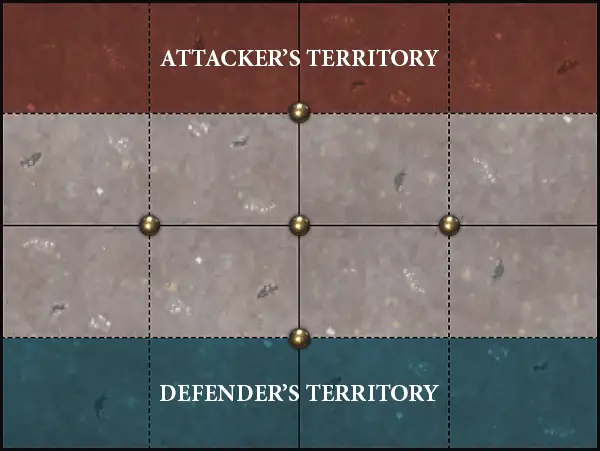 | ||
Battleplan The Realmstone Cache 2 2Alarielle’s great Rite of Life has stirred the Realm of Beasts, such that the lands themselves seem to shift and growl with predatory urges. In these times, the power of amberbone appears to have grown even more potent, rendering the most concentrated nodes of the realmstone quite volatile... THE ARMIES Each player picks an army and then they roll off. The winner chooses which player is the attacker and which is the defender.THE BATTLEFIELD The defender sets up the battlefield. First, they set up objectives as shown on the map. Then, they set up the recommended number of terrain features shown on the Pitched Battles table.DEPLOYMENT The attacker picks which territory is their territory. The other territory is the defender’s territory. The players then use alternating deployment, starting with the attacker. Each player must set up their units wholly within their territory.UNSTABLE REALMSTONE At the start of the third battle round, before determining who will take the first turn, the Realmstone Cache detonates and scatters fragments of realmstone across the battlefield. The defender must remove the objective at the centre of the battlefield and roll a dice. The roll determines the locations of the scattered fragments. Place 2 new objectives on the battlefield in the locations determined by the roll.Designer’s Note: The locations of the scattered fragments do not change, even if the objective at the centre of the battlefield is moved to a different location before the cache detonates. VICTORY POINTS Each player scores victory points at the end of each of their turns as follows:- Score 1 victory point if you control at least one objective. - Score 1 victory point if you control two or more objectives. - Score 1 victory point if you control more objectives than your opponent. - Score 2 victory points if you completed the battle tactic you picked that turn. GRAND STRATEGY Each player scores 3 victory points at the end of the battle if they completed their grand strategy.BATTLE LENGTH The battle lasts for 5 battle rounds.GLORIOUS VICTORY The player with the most victory points at the end of the battle wins a major victory.If the players are tied on victory points at the end of the battle, then the player that completed the most battle tactics wins a minor victory. If both players completed the same number of battle tactics, then if only one player completed their grand strategy, that player wins a minor victory. If both players or neither player completed their grand strategy, the battle is a draw. 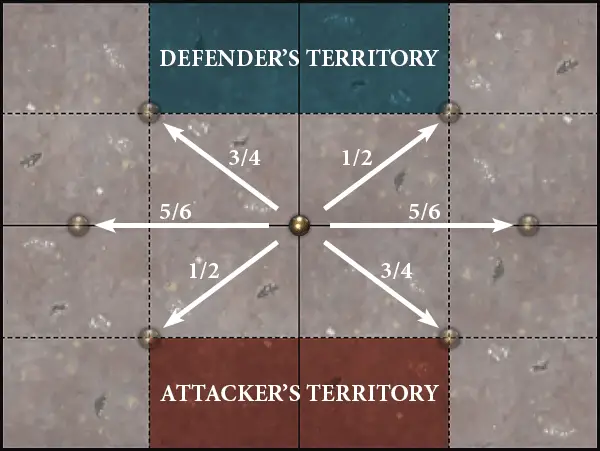 | ||
Battleplan Battlelines Drawn 3 3In this enclosed space, each side must form a line of battle whilst seeking to collapse that of their opponent. There is no opportunity for a surprise attack; victory will be decided at the front ranks. THE ARMIES Each player picks an army and then they roll off. The winner chooses which player is the attacker and which is the defender.THE BATTLEFIELD The defender sets up the battlefield. First, they set up objectives as shown on the map. Then, they set up the recommended number of terrain features shown on the Pitched Battles table.DEPLOYMENT The attacker picks which territory is their territory. The other territory is the defender’s territory. The players then use alternating deployment, starting with the attacker. Each player must set up their units wholly within their territory and more than 9" from enemy territory.HOLD FAST In this battle, the players fight for control of the 4 quarters of the battlefield instead of objectives. Each quarter is controlled in the same manner as an objective (core rules, 18.1.1), except that models must be wholly within a quarter to be able to contest it. In addition, each quarter counts as an objective for the purposes of grand strategies, battle tactics and abilities.CONFINED CAVERNS In this battle, units cannot be removed from the battlefield with an effect that would allow them to be set up again later in the battle.VICTORY POINTS Each player scores victory points at the end of each of their turns as follows:- Score 1 victory point if you control at least one quarter of the battlefield. - Score 1 victory point if you control two or more quarters of the battlefield. - Score 1 victory point if you control more quarters of the battlefield than your opponent. - Score 2 victory points if you completed the battle tactic you picked that turn. GRAND STRATEGY Each player scores 3 victory points at the end of the battle if they completed their grand strategy.BATTLE LENGTH The battle lasts for 5 battle rounds.GLORIOUS VICTORY The player with the most victory points at the end of the battle wins a major victory.If the players are tied on victory points at the end of the battle, then the player that completed the most battle tactics wins a minor victory. If both players completed the same number of battle tactics, then if only one player completed their grand strategy, that player wins a minor victory. If both players or neither player completed their grand strategy, the battle is a draw. 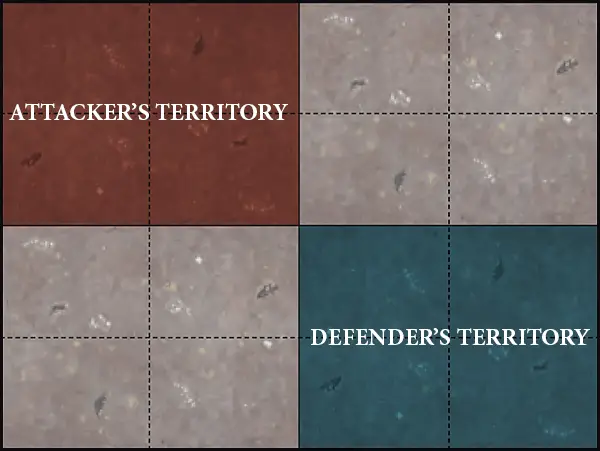 | ||
Battleplan The Lurkers Below 4 4The path to victory in this place is infested with scuttling predators that prowl the shadows. You must either cull them or drive them off before you make progress, lest you leave your rear lines vulnerable as you advance. THE ARMIES Each player picks an army and then they roll off. The winner chooses which player is the attacker and which is the defender.THE BATTLEFIELD The defender sets up the battlefield. First, they set up objectives as shown on the map. Then, they set up the recommended number of terrain features shown on the Pitched Battles table.DEPLOYMENT The attacker picks which territory is their territory. The other territory is the defender’s territory.The players then use alternating deployment, starting with the attacker. Each player must set up their units wholly within their territory. CONQUEROR’S MOMENTUM In this battle, you must control the objective on the border of your territory before you can contest the objective at the centre of the battlefield. In addition, you must control the objective at the centre of the battlefield before you can contest the objective on the border of your opponent’s territory.DEADLY DENIZENS Objectives cannot be controlled in the first battle round.BATTLE LENGTH The battle lasts for 5 battle rounds.GLORIOUS VICTORY Starting from the third battle round, a player immediately wins a major victory if they control all of the objectives on the battlefield.If neither player has won a major victory by the end of the battle, then the player that completed the most battle tactics wins a minor victory. If both players completed the same number of battle tactics, then if only one player completed their grand strategy, that player wins a minor victory. If both players or neither player completed their grand strategy, the battle is a draw. 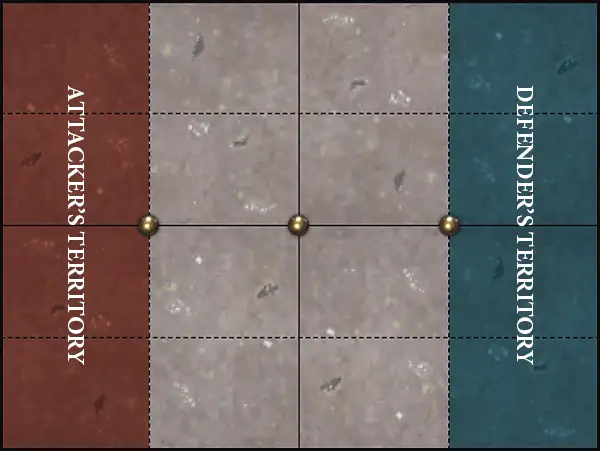 | ||
Battleplan In the Presence of Idols 5 5Famed warriors march to war on both sides this day, acting as anchors in their respective battle lines. However, their martial pride drives them to square off against one another in an attempt to assert dominance. These clashes between champions could prove crucial in determining the outcome of this engagement. THE ARMIES Each player picks an army and then they roll off. The winner chooses which player is the attacker and which is the defender.THE BATTLEFIELD The defender sets up the battlefield. First, they set up objectives as shown on the map. Then, they set up the recommended number of terrain features shown on the Pitched Battles table.DEPLOYMENT The attacker picks which territory is their territory. The other territory is the defender’s territory. The players then use alternating deployment, starting with the attacker. Each player must set up their units wholly within their territory and more than 9" from their opponent’s territory.INSPIRING ICONS After deployment but before determining who will take the first turn in the first battle round, each player must pick 3 different friendly units on the battlefield, starting with the attacker. The units each player picks are their idol units for the battle. LORD KROAK and INCARNATE units cannot be picked as idol units.Halve the number of models that flee due to a failed battleshock test (rounding down) while their unit is wholly within 6" of any idol units in their army. VICTORY POINTS Each player scores victory points at the end of each of their turns as follows:- Score 1 victory point if you control at least one objective. - Score 1 victory point if you control two or more objectives. - Score 1 victory point if you control more objectives than your opponent. - Score 1 victory point for each enemy idol unit that was destroyed by a friendly idol unit during that turn. - Score 2 victory points if you completed the battle tactic you picked that turn. GRAND STRATEGY Each player scores 3 victory points at the end of the battle if they completed their grand strategy.BATTLE LENGTH The battle lasts for 5 battle rounds.GLORIOUS VICTORY The player with the most victory points at the end of the battle wins a major victory.If the players are tied on victory points at the end of the battle, then the player that completed the most battle tactics wins a minor victory. If both players completed the same number of battle tactics, then if only one player completed their grand strategy, that player wins a minor victory. If both players or neither player completed their grand strategy, the battle is a draw. 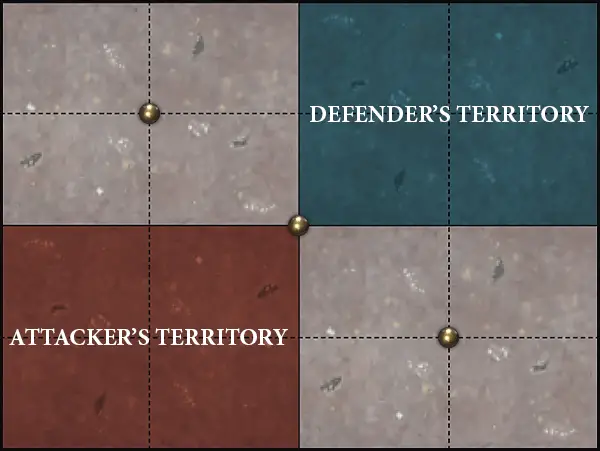 | ||
Battleplan The Nidus Paths 6 6This area is riddled with tunnels and holes, as though it were the hive of some colony of monstrous insects. Right now, pondering what may have created them will do you no good, for the enemy approaches. However, these twisted paths might well provide the perfect opportunity to launch a surprise attack... THE ARMIES Each player picks an army and then they roll off. The winner chooses which player is the attacker and which is the defender.THE BATTLEFIELD The defender sets up the battlefield. First, they set up objectives as shown on the map. Then, they set up the recommended number of terrain features shown on the Pitched Battles table.DEPLOYMENT The attacker picks which territory is their territory. The other territory is the defender’s territory. The players then use alternating deployment, starting with the attacker. Each player must set up their units wholly within their territory and more than 9" from their opponent’s territory.THE NIDUS PATH The battlefield hosts 4 tunnels called nidus paths. Each nidus path is located at a corner of the battlefield edge as shown on the map.At the end of their movement phase, players can pick 1 friendly unit wholly within 6" of a nidus path. If they do so, they must remove that unit from the battlefield and set it up again wholly within 6" of that nidus path’s twin, more than 9" from all enemy units. For example, if a unit is removed from the battlefield via nidus path B in the top-left corner of the map, that unit must be set up again wholly within 6" of nidus path B in the bottom-right corner of the map. VICTORY POINTS Each player scores victory points at the end of each of their turns as follows:- Score 1 victory point if you control at least one objective. - Score 1 victory point if you control two or more objectives. - Score 1 victory point if you control more objectives than your opponent. - Score 2 victory points if you completed the battle tactic you picked that turn. GRAND STRATEGY Each player scores 3 victory points at the end of the battle if they completed their grand strategy.BATTLE LENGTH The battle lasts for 5 battle rounds.GLORIOUS VICTORY The player with the most victory points at the end of the battle wins a major victory.If the players are tied on victory points at the end of the battle, then the player that completed the most battle tactics wins a minor victory. If both players completed the same number of battle tactics, then if only one player completed their grand strategy, that player wins a minor victory. If both players or neither player completed their grand strategy, the battle is a draw. 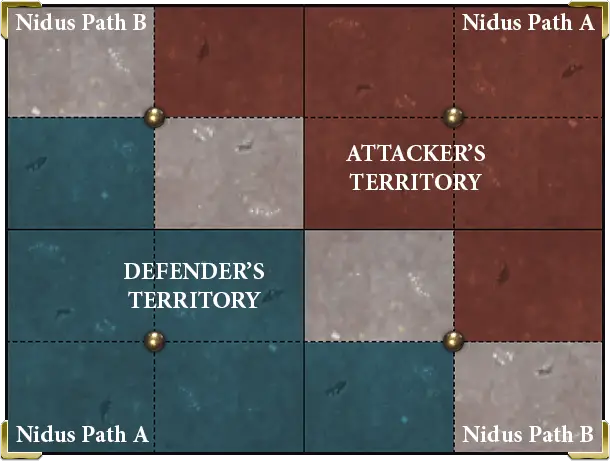 | ||
Battleplan The Mighty and the Cunning 1 1This is no place for the weak. Victory here will be decided by those who have confronted the worst the realms have to offer and survived to spit fate in the eye. THE ARMIES Each player picks an army and then they roll off. The winner chooses which player is the attacker and which is the defender.THE BATTLEFIELD The defender sets up the battlefield. First, they set up objectives as shown on the map. Then, they set up the recommended number of terrain features shown on the Pitched Battles table.DEPLOYMENT The attacker picks which territory is their territory. The other territory is the defender’s territory. The players then use alternating deployment, starting with the attacker. Each player must set up their units wholly within their territory.ON THEIR TERMS In this battle, the same objective can be picked as the proving ground more than once per battle.SHATTER THEIR STRENGTH You score 2 victory points each time an enemy GALLETIAN VETERANS unit is destroyed. Score 1 additional victory point if that enemy GALLETIAN VETERANS unit was contesting an objective when it was destroyed.VICTORY POINTS Each player scores victory points at the end of each of their turns as follows:- Score 1 victory point if you control at least one objective. - Score 1 victory point if you control two or more objectives. - Score 1 victory point if you control more objectives than your opponent. - Score 2 victory points if you completed the battle tactic you picked that turn. GRAND STRATEGY Each player scores 3 victory points at the end of the battle if they completed their grand strategy.BATTLE LENGTH The battle lasts for 5 battle rounds.GLORIOUS VICTORY The player with the most victory points at the end of the battle wins a major victory.If the players are tied on victory points at the end of the battle, then the player that completed the most battle tactics wins a minor victory. If both players completed the same number of battle tactics, then if only one player completed their grand strategy, that player wins a minor victory. If both players or neither player completed their grand strategy, the battle is a draw. 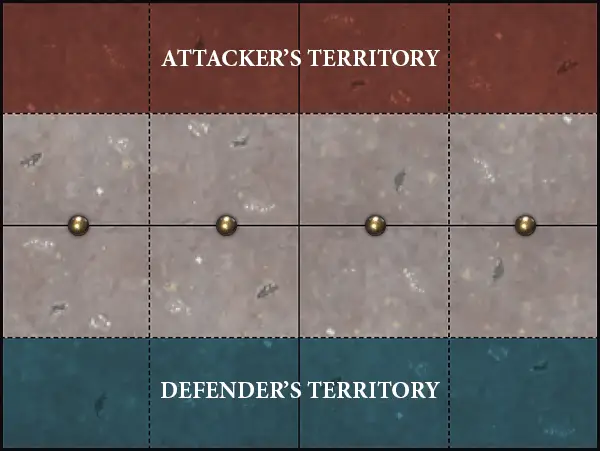 | ||
Battleplan Head-on Collision 2 2Focus all of your might and crush your enemy in a headlong assault. Trample those who fall and tear out the throat of your prey - Ghur demands it! THE ARMIES Each player picks an army and then they roll off. The winner chooses which player is the attacker and which is the defender.THE BATTLEFIELD The defender sets up the battlefield. First, they set up objectives as shown on the map. Then, they set up the recommended number of terrain features shown on the Pitched Battles table.DEPLOYMENT The attacker picks which territory is their territory. The other territory is the defender’s territory. The players then use alternating deployment, starting with the attacker. Each player must set up their units wholly within their territory and more than 9" from their opponent’s territory.DEADLY DENIZENS In this battle, objectives cannot be controlled in the first battle round. Players do not gain control of objectives after set-up is complete (core rules, 18.1.1).VICTORY POINTS Each player scores victory points at the end of each of their turns as follows:- Score 1 victory point if you control the objective wholly within your territory. - Score 2 victory points if you control the objective at the centre of the battlefield. - Score 4 victory points if you control the objective wholly within your opponent’s territory. - Score 1 victory point if you gained control of an objective this turn and there are any friendly GALLETIAN VETERANS units within 6" of that objective. - Score 2 victory points if you completed the battle tactic you picked that turn. GRAND STRATEGY Each player scores 3 victory points at the end of the battle if they completed their grand strategy.BATTLE LENGTH The battle lasts for 5 battle rounds.GLORIOUS VICTORY The player with the most victory points at the end of the battle wins a major victory.If the players are tied on victory points at the end of the battle, then the player that completed the most battle tactics wins a minor victory. If both players completed the same number of battle tactics, then if only one player completed their grand strategy, that player wins a minor victory. If both players or neither player completed their grand strategy, the battle is a draw. 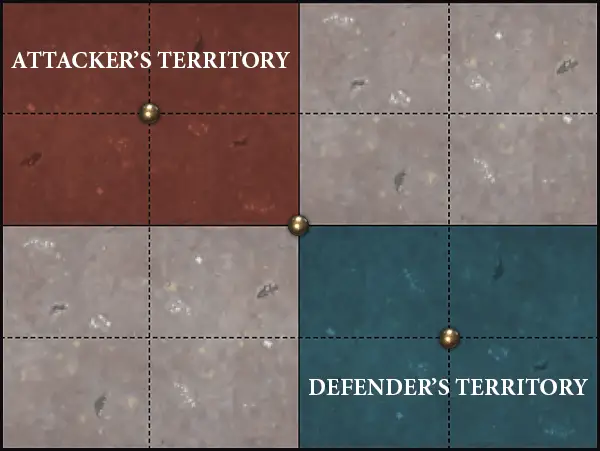 | ||
Battleplan Won’t Back Down 3 3Like alpha wolves guarding a fresh kill, your troops will not relinquish their gains easily - a trait that you can use to your advantage. Harness your warriors’ determination to safeguard the assets you manage to seize in this place. THE ARMIES Each player picks an army and then they roll off. The winner chooses which player is the attacker and which is the defender.THE BATTLEFIELD The defender sets up the battlefield. First, they set up objectives as shown on the map. Then, they set up the recommended number of terrain features shown on the Pitched Battles table.DEPLOYMENT The attacker picks which territory is their territory. The other territory is the defender’s territory. The players then use alternating deployment, starting with the attacker. Each player must set up their units wholly within their territory and more than 9" from their opponent’s territory.RALLY POINTS In this battle, if a player uses the Rally command and the unit that receives the command is wholly within 6" of an objective they control, when they roll a dice for a slain model from that unit, they can return 1 slain model to that unit on a 5+ instead of only a 6. If that unit is a GALLETIAN VETERANS unit, they can return 1 slain model to that unit on a 4+ instead.VICTORY POINTS Each player scores victory points at the end of each of their turns as follows:- Score 1 victory point if you control at least one objective. - Score 1 victory point if you control two or more objectives. - Score 1 victory point if you control more objectives than your opponent. - Score 2 victory points if you completed the battle tactic you picked that turn. GRAND STRATEGY Each player scores 3 victory points at the end of the battle if they completed their grand strategy.BATTLE LENGTH The battle lasts for 5 battle rounds.GLORIOUS VICTORY The player with the most victory points at the end of the battle wins a major victory.If the players are tied on victory points at the end of the battle, then the player that completed the most battle tactics wins a minor victory. If both players completed the same number of battle tactics, then if only one player completed their grand strategy, that player wins a minor victory. If both players or neither player completed their grand strategy, the battle is a draw. 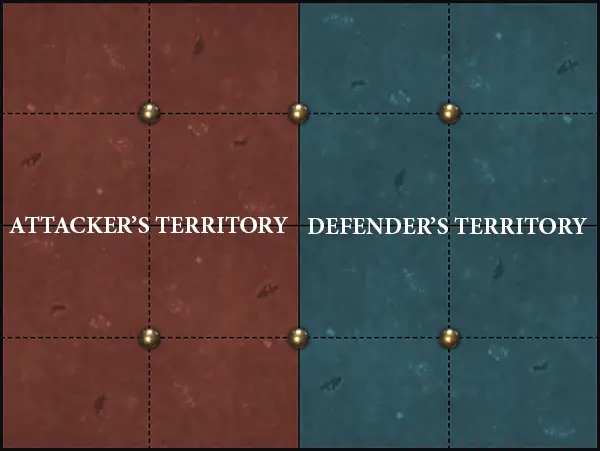 | ||
Battleplan The Silksteel Nests 4 4Silksteel fetches a hefty price in the markets of the realms. Your scouts have reported a cavern in the vicinity replete with the stuff, and you intend to lay claim to its bounty before the enemy does the same. Your rushed efforts to harvest the resource may well draw the attention of its unsettling creators, but this is a risk that you are willing to take! THE ARMIES Each player picks an army and then they roll off. The winner chooses which player is the attacker and which is the defender.THE BATTLEFIELD The defender sets up the battlefield. First, they set up objectives as shown on the map. Then, they set up the recommended number of terrain features shown on the Pitched Battles table.DEPLOYMENT The attacker picks which territory is their territory. The other territory is the defender’s territory. The players then use alternating deployment, starting with the attacker. Each player must set up their units wholly within their territory and more than 9" from their opponent’s territory.PILLAGING OBJECTIVES From the start of the second battle round, after you score victory points, you can pillage 1 objective that you control, that is wholly within your opponent’s territory and that is within 1" of a friendly unit. If you do so, you score 1 additional victory point. The objective is then removed from play. You cannot pillage more than 1 objective per turn.SCUTTLING HORRORS After an objective has been pillaged, before it is removed from play, the player whose turn is taking place must roll 2D6 for each unit within 9" of the pillaged objective. If the roll is equal to or greater than the Bravery characteristic of that unit, that unit suffers D3 mortal wounds.VICTORY POINTS Each player scores victory points at the end of each of their turns as follows:- Score 1 victory point if you control at least one objective. - Score 1 victory point if you control two or more objectives. - Score 1 victory point if you control more objectives than your opponent. - Score 2 victory points if you completed the battle tactic you picked that turn. GRAND STRATEGY Each player scores 3 victory points at the end of the battle if they completed their grand strategy.BATTLE LENGTH The battle lasts for 5 battle rounds.GLORIOUS VICTORY The player with the most victory points at the end of the battle wins a major victory.If the players are tied on victory points at the end of the battle, then the player that completed the most battle tactics wins a minor victory. If both players completed the same number of battle tactics, then if only one player completed their grand strategy, that player wins a minor victory. If both players or neither player completed their grand strategy, the battle is a draw. 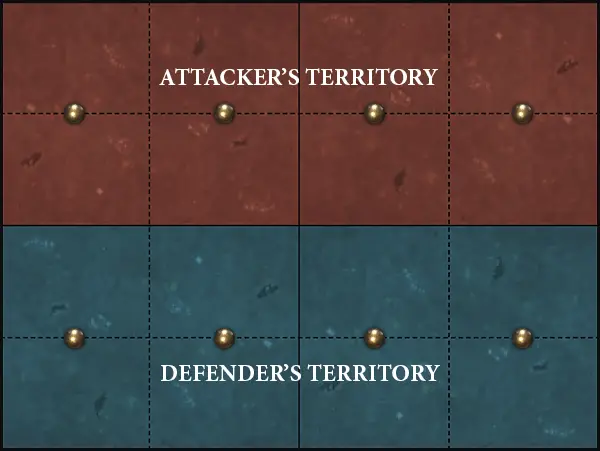 | ||
Battleplan Close to the Chest 5 5This vast cavern is rich in the treasures of Ghur, though your learned advisors inform you that some are more valuable than others. Seize what you can, and make use of your runners to ensure that the most lucrative artefacts do not fall into the enemy’s hands. THE ARMIES Each player picks an army and then they roll off. The winner chooses which player is the attacker and which is the defender.THE BATTLEFIELD The defender sets up the battlefield. First, they set up objectives as shown on the map. Then, they set up the recommended number of terrain features shown on the Pitched Battles table.DEPLOYMENT The attacker picks which territory is their territory. The other territory is the defender’s territory. The players then use alternating deployment, starting with the attacker. Each player must set up their units wholly within their territory and more than 9" from enemy territory.ALPHA OBJECTIVE The map shows which objectives belong to which player. At the start of each player’s turn, the opposing player picks 1 of their own objectives to be the alpha objective for that turn. For example, if it is attacker’s turn, the defender picks 1 of the defender’s objectives (as shown on the map) to be the alpha objective that turn.VICTORY POINTS Each player scores victory points at the end of each of their turns as follows:- Score 1 victory point if you control at least one objective. - Score 1 victory point if you control two or more objectives. - Score 1 victory point if you control more objectives than your opponent. - Score 1 victory point if you control the alpha objective. - Score 2 victory points if you completed the battle tactic you picked that turn. GRAND STRATEGY Each player scores 3 victory points at the end of the battle if they completed their grand strategy.BATTLE LENGTH The battle lasts for 5 battle rounds.GLORIOUS VICTORY The player with the most victory points at the end of the battle wins a major victory.If the players are tied on victory points at the end of the battle, then the player that completed the most battle tactics wins a minor victory. If both players completed the same number of battle tactics, then if only one player completed their grand strategy, that player wins a minor victory. If both players or neither player completed their grand strategy, the battle is a draw. 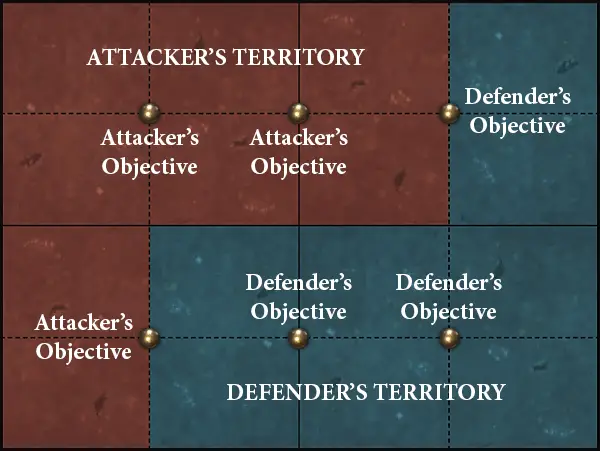 | ||
Battleplan Turf War 6 6All bets are on the table in this confrontation. The time for clever manoeuvres is over; victory will be determined in the cut and thrust of close combat, where a warrior can see the whites of their opponent’s eyes and the sweat of the combatants hangs over the melee like a reeking pall. THE ARMIES Each player picks an army and then they roll off. The winner chooses which player is the attacker and which is the defender.THE BATTLEFIELD The defender sets up the battlefield. First, they set up objectives as shown on the map. Then, they set up the recommended number of terrain features shown on the Pitched Battles table.DEPLOYMENT The attacker picks which territory is their territory. The other territory is the defender’s territory. The players then use alternating deployment, starting with the attacker. Each player must set up their units wholly within their territory and more than 9" from enemy territory.NO RESERVES All units must be set up on the battlefield before the battle begins. If a unit is set up in reserve, all of the models in the unit are slain and the unit is destroyed.CLAUSTROPHOBIC KILLING GROUNDS Summoned units cannot shoot or charge in the turn in which they were added to your army.VICTORY POINTS Each player scores victory points at the end of each of their turns as follows:- Score 1 victory point if you control at least one objective. - Score 1 victory point if you control both objectives. - Score 1 victory point if you control more objectives than your opponent. - Score 2 victory points if you completed the battle tactic you picked that turn. GRAND STRATEGY Each player scores 3 victory points at the end of the battle if they completed their grand strategy.BATTLE LENGTH The battle lasts for 5 battle rounds.GLORIOUS VICTORY The player with the most victory points at the end of the battle wins a major victory.If the players are tied on victory points at the end of the battle, then the player that completed the most battle tactics wins a minor victory. If both players completed the same number of battle tactics, then if only one player completed their grand strategy, that player wins a minor victory. If both players or neither player completed their grand strategy, the battle is a draw. 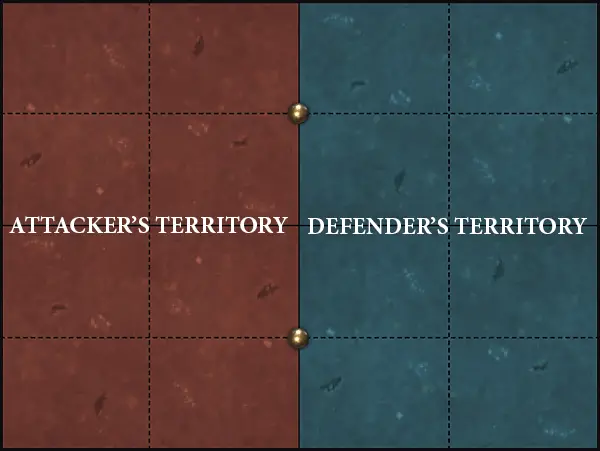 | ||
Pitched Battle Publications 2022-23 - Season 1
As Warhammer Age of Sigmar continues to grow, naturally we will continue to write rules for the game. However, when you are playing competitively, sometimes it’s hard to know which of these rules are ‘legal’ - in other words, which rules you can use in Pitched Battles. In this section we’ve provided a handy at-a-glance list which shows you all the publications whose rules you are allowed to use in Pitched Battles.Core
- Warhammer Age of Sigmar Core Book
- General’s Handbook: Pitched Battles 2022-23 - Season 1
- Pitched Battle Profiles 2022-23 - Season 1
Battletomes
- Battletome: Beasts of Chaos
- Battletome: Blades of Khorne
- Battletome: Cities of Sigmar
- Battletome: Daughters of Khaine
- Battletome: Disciples of Tzeentch
- Battletome: Flesh-eater Courts
- Battletome: Fyreslayers
- Battletome: Gloomspite Gitz
- Battletome: Hedonites of Slaanesh
- Battletome: Idoneth Deepkin
- Battletome: Kharadron Overlords
- Battletome: Lumineth Realm-lords
- Battletome: Maggotkin of Nurgle
- Battletome: Nighthaunt
- Battletome: Ogor Mawtribes
- Battletome: Orruk Warclans
- Battletome: Ossiarch Bonereapers
- Battletome: Seraphon
- Battletome: Skaven
- Battletome: Slaves to Darkness
- Battletome: Sons of Behemat
- Battletome: Soulblight Gravelords
- Battletome: Stormcast Eternals
- Battletome: Sylvaneth
Expansions
- Wrath of the Everchosen
- Broken Realms: Morathi
- Broken Realms: Teclis
- Broken Realms: Be’lakor
- Broken Realms: Kragnos
Other Publications
- Compendium: Monstrous Arcanum (excluding Warhammer Legends: Monstrous Arcanum)
- White Dwarf Battletome Updates
- Season of War: Thondia
Core Battalions
You can include any of the following core battalions in your army in addition to those found in the core rules. In addition, you cannot include the same core battalion from those shown below more than once in your army.
|
|
| ||||||||
| Most rules for artefacts of power refer to the bearer. The bearer is the model to which an artefact of power has been given (see section 27.5.2 for some examples). | ||
The MEGA-GARGANT keyword is used in the following Sons of Behemat warscrolls:
- Unit champions can issue commands to their own unit (see 22.3.2).
- HEROES can issue commands to units that are wholly within 12" of them.
- Generals can issue commands to units that are wholly within 18" of them.
- TOTEMS can issue commands to units that are wholly within 18" of them.
When you set up a reserve unit, either during deployment or once the battle is underway, you must tell your opponent that the unit is in reserve and keep it to one side instead of placing it on the battlefield. At the start of the fourth battle round, units that are still in reserve are destroyed. Units cannot cast spells or use abilities while they are in reserve unless the spell or ability specifically says it can be used by reserve units.
| Reserve units are picked as part of your army before the battle begins, while summoned units are units added to your army once the battle is underway. Models that have been removed from play can be used as part of a summoned unit. | ||
| If a slain model is returned to its unit in the same turn that it is slain, it still counts as having been slain in that battle round for the purposes of battleshock tests. | ||
You can use this command ability at the start of the hero phase. The unit that receives the command must be more than 3" from all enemy units. Roll 1 dice for each slain model from that unit. For each 6, you can return 1 slain model to that unit.
You can only return models to that unit that have a combined Wounds characteristic of 10 or less. For example, if the unit that received the command has a Wounds characteristic of 2, you can return a maximum of 5 models to that unit.
Mortal wounds caused while a unit is attacking are allocated at the same time as wounds caused by the unit’s attacks: after all of the unit’s attacks have been made. Mortal wounds caused at other times are allocated as soon as they are caused. Mortal wounds are allocated in the same way as wounds and are treated in the same manner as wounds for rules purposes.
Contents  6 Turf War 6 Turf War | ||
